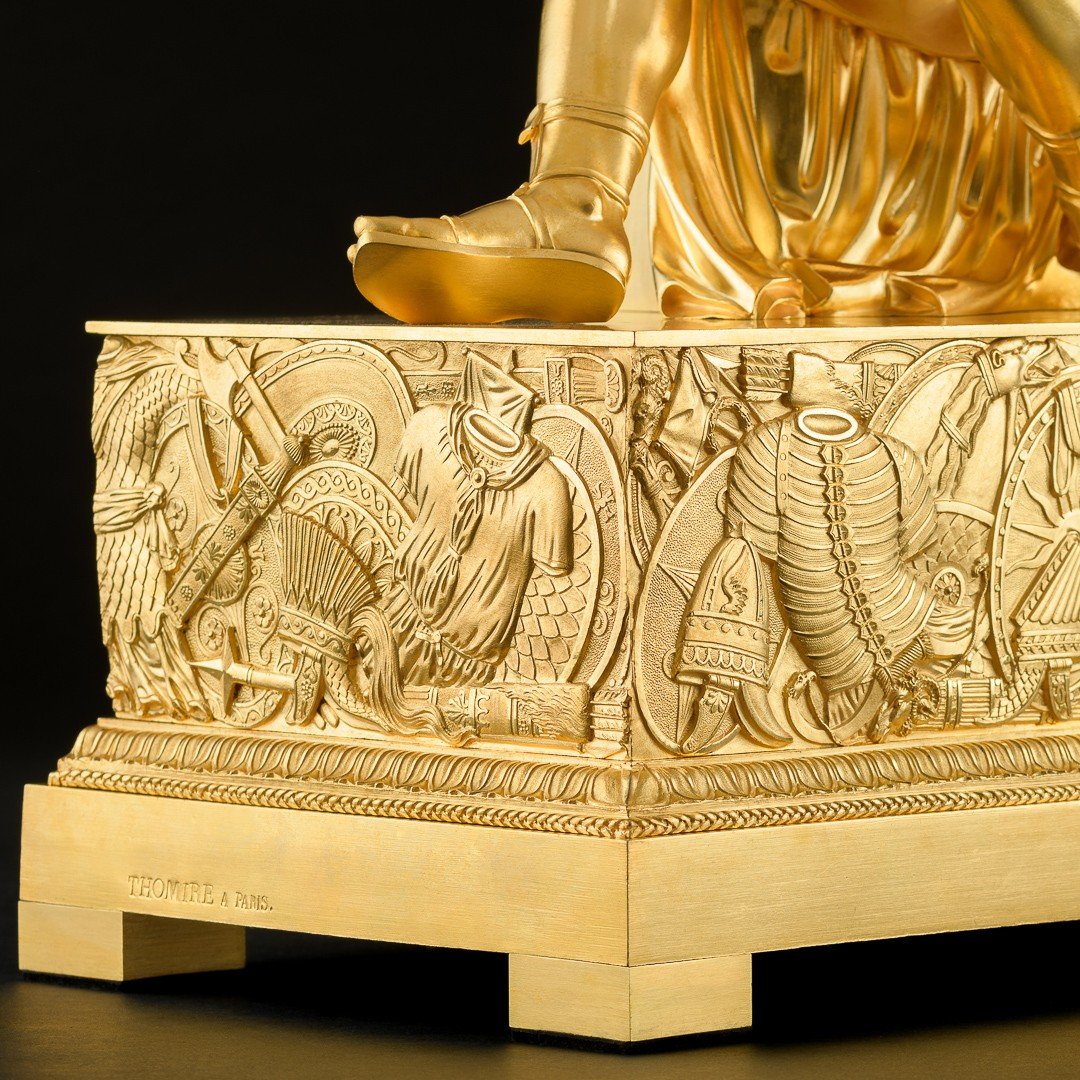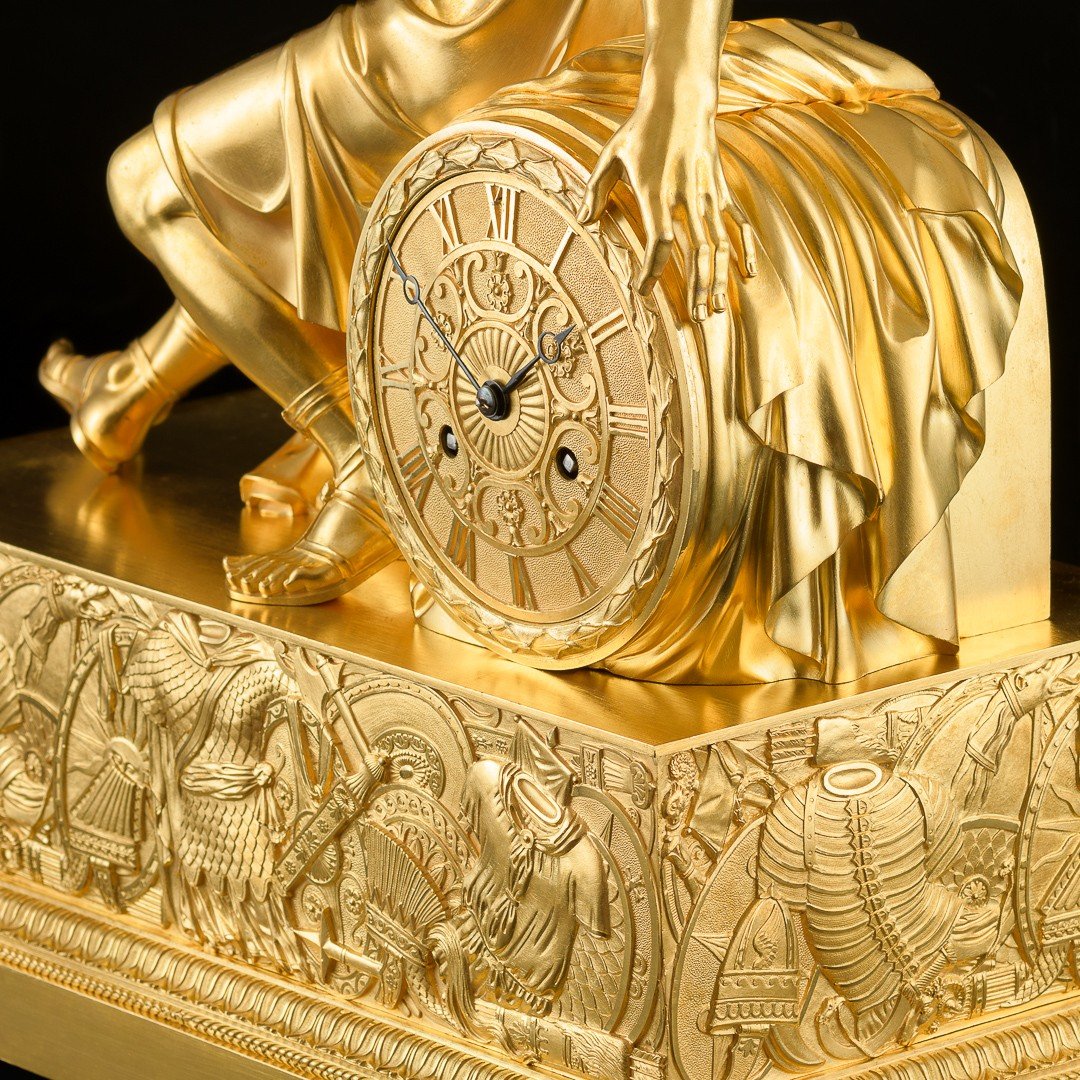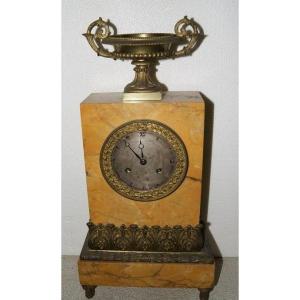See our website for more detailed photos: LINK
We send this article worldwide, professionally packaged, with registered and fully insured shipping at a fair price.
An exceptional and exceedingly rare gilt-bronze Empire mantel clock, with the bronzes signed by Pierre-Philippe Thomire and the clockwork signed by Louis Moinet, one of the most influential clockmakers of the early 19th century. It is well-known that Thomire and Moinet worked in close collaboration, with the majority, if not all, of Moinet’s clocks being crafted in partnership with the renowned bronzier Thomire.
Our clock’s subject is a masterfully sculpted depiction of a classical soldier, exuding a noble and contemplative presence. The bearded figure sits in a pensive pose, his gaze directed upward as he holds a sword, with his helmet resting to one side. The frieze adorning the clock’s base is richly embellished with war trophies, including weapons, helmets, and armour. Uniquely, this frieze not only decorates the entire front of the clock’s base but also continues seamlessly along both sides, an exceptionally rare and striking feature.
This seated soldier may represent Odysseus in the aftermath of a significant battle, reflecting on the conclusion of the Trojan War or the tribulations of his long journey home. The figure captures the multifaceted character of Odysseus, embodying the complex tension between war and peace, action and introspection, triumph and loss. Odysseus is portrayed as more than a warrior—he is also a thinker and strategist, renowned for his wisdom and cunning. Frequently depicted in art holding a sword or weapon, his thoughtful seated posture here symbolises the duality of his nature as both a formidable fighter and a profound thinker.
A nearly identical design of the clock’s frieze, featuring military trophies, appears in a drawing after a clock from the workshop of Pierre-Philippe Thomire, preserved in the National Museum in Stockholm. This drawing is based on a model likely created between 1810 and 1815. Thomire, in turn, drew inspiration for this design from the pedestal of Trajan’s Column in Rome, which features a comparable arrangement of war trophies. This connection represents one of the rare instances of a direct reference to an ancient model, underscoring the historical and artistic significance of this clock.
This Empire mantel clock, with amazing sculptural detail and craftsmanship, is made from finely chiselled mercury gilded bronze. It has been professionally cleaned and is in excellent condition.
The bronzes of this Empire clock are signed on the lower left side “THOMIRE A PARIS.” and the clockwork carries the signature “L.MOINET A PARIS” on the back-plate of the clockwork.
Origin: Paris, Empire period circa 1810.
Dimensions: 56 cm (22″) high, 44 cm (17.3″) wide and 23 cm (9.1″) deep.
Pierre-Philippe Thomire (1751-1843)
Pierre-Philippe Thomire was a French sculptor, who became the most prominent producer of ornamental patinated and gilt-bronze objects and furniture mounts in the First French Empire period. Although trained as a sculptor, Thomire decided to follow his father into the profession of bronze caster. He had received his training in the workshop of Pierre Gouthière, the outstanding Parisian ciseleur-doreur working in the Louis XVI style, before establishing his own shop in 1776.
In 1804 Thomire acquired the business of the marchand-mercier, Martin-Eloi Lignereux. The company employed a large workforce in a workshop at rue Boucherat and a showroom at rue Taitbout. From there Thomire retailed a large range of decorative objects inspired by antiquity including candelabra, extravagant centrepieces, clock cases and monumental Greek and Roman style urns and vases.
Pierre-Philippe Thomire was the greatest craftsman of his age to work in gilt bronze. He was patronised by Louis XVI, Napoleon and Louis XVIII as well as foreign monarchy and aristocracy. Thomire’s fame and notoriety was then propelled to even greater heights after the Revolution when in 1806 he became the first bronzier to be awarded a gold medal at the Exposition des Produits de l’Industrie. In 1809 he won another gold medal and was also appointed ciseleur de l’Empereur. In addition to Napoleon himself, Thomire was patronised by the Emperor’s family and many foreign royal courts. Because of the large number of pieces Thomire supplied to the palaces, his firm became fournisseur de leurs majestés (Furniture Suppliers to their Majesties) two years later. His work represents some of the finest examples of the Empire design.
At the height of his business, it is estimated that Thomire employed six or seven hundred workers. Thomire retired from his firm in 1823.
Louis Moinet: A Pioneer of Horology
Louis Moinet (1768–1853) was a renowned Parisian clockmaker and inventor, celebrated as the creator of the chronograph. Born in Bourges, France, into a prosperous farming family, Moinet displayed early talent in art and mechanics. He studied classical subjects, excelling in sculpture and painting, while nurturing a deep passion for horology.
After honing his skills in watchmaking under a master craftsman, Moinet spent five years in Italy, studying architecture, sculpture, and painting in Rome and Florence. He returned to Paris as a professor at the Académie des Beaux-Arts and became active in various artistic and scholarly circles.
Moinet’s dedication to horology eventually took precedence over his artistic pursuits. In 1816, he invented the first chronograph, a revolutionary timekeeping device. His creations included an automaton clock for Napoleon, where music triggered a scene of coronation, as well as bespoke timepieces for notable figures like King George IV, Tsar Alexander I, and American presidents Thomas Jefferson and James Monroe.
Collaborating closely with famed bronzier Pierre-Philippe Thomire, Moinet crafted clocks that were both technical marvels and exquisite works of art. Today, his masterpieces are exhibited in esteemed institutions such as the Louvre, Versailles, and Florence’s Palazzo Pitti, cementing his legacy as a visionary of horology.
Literature
- H. Ottomeyer, P. Proschel et al., ” Vergoldete Bronzen – Die Bronzearbeiten des Spätbarock und Klassizismus”, München, 1986, Vol. I, p. 346, fig. 5.5.17.
- Tardy, “Dictionnaire des horlogers français”, p. 467, 613.



































 Le Magazine de PROANTIC
Le Magazine de PROANTIC TRÉSORS Magazine
TRÉSORS Magazine Rivista Artiquariato
Rivista Artiquariato